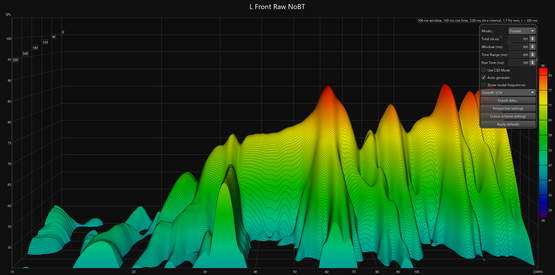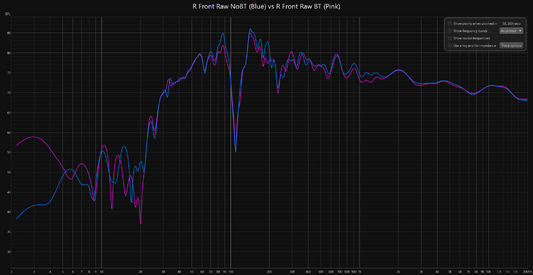How can I tell from my measurements that did bass traps are making my system's sound better and not messing up at least?
For evaluating time domain performance of bass traps, which graphs should I read and how?
Also, is there good rule of thumb for determining how much should I absorb? I guess I can't do more in my current room, maybe in the future.
I've built and installed 4 DIY porus material bass traps in my living room in the beginning of this year.
Each panel sizes about W60cm x H72 cm x D10cm. For the porus material I've used cellrouse fiber insulation material which weighs about 90kg/m3. I stacked 2 panels in 2 corners.
I know that many people would say that fully stacking in 4 corners is the minimal recommended amount, I just tried my best to treat my room with available living room space and my limited DIY skills.
I re-measured bass traps to see if bass traps are still working as expected, and previous measurements were really showing the perforamnce of DIY bass traps.
I only measured in single position so that the conditions other than bass traps won't change.
This time there are not much changes in frequency response graphs, except for higher bass frequencies like 200-300Hz.
When I measured the traps in the beginning of this year, the SPL at 100Hz was below 50dB at worst positions because of the sharp dip.
Installing traps restored some lost SPLs, increasing the SPL at 100Hz to 55dB or so at any positions.
This time the SPL at 100Hz was 55dB with or without bass traps.
I've only looked at frequency response graphs because that seemed like the easiest one to interpret.
Later I've learned about other types of graphs that shows time domain performance of bass traps such as waterwall, though I was not sure how to interpret correctly.
With or without room correction systems like Dirac and Audyssey, my system still sounds good at least to my ears, I don't think I've heard something weird.
My living room's system is 2.1ch configuration.
For "raw" measurements I've only enabled front speakers and disabled the subwoofer.
I've also included a measurements with Dirac DLBC and subwoofer enabled.
I didn't re-callibrate as that will chnage conditions other than bass traps. (Callibrated with bass traps present)
Using Dirac and subwoofer alone lowered the depth of the dip at 100Hz by large margin.
If you have only single listening position and only want to be able to fix frequency response irregularities, Dirac and subwoofer might be enough?
Amp: Denon AVR-X3800H
Front: ELAC DBR62
Subwoofer: SVS 3000 Micro (Only enabled for measurements with Dirac)
For evaluating time domain performance of bass traps, which graphs should I read and how?
Also, is there good rule of thumb for determining how much should I absorb? I guess I can't do more in my current room, maybe in the future.
I've built and installed 4 DIY porus material bass traps in my living room in the beginning of this year.
Each panel sizes about W60cm x H72 cm x D10cm. For the porus material I've used cellrouse fiber insulation material which weighs about 90kg/m3. I stacked 2 panels in 2 corners.
I know that many people would say that fully stacking in 4 corners is the minimal recommended amount, I just tried my best to treat my room with available living room space and my limited DIY skills.
I re-measured bass traps to see if bass traps are still working as expected, and previous measurements were really showing the perforamnce of DIY bass traps.
I only measured in single position so that the conditions other than bass traps won't change.
This time there are not much changes in frequency response graphs, except for higher bass frequencies like 200-300Hz.
When I measured the traps in the beginning of this year, the SPL at 100Hz was below 50dB at worst positions because of the sharp dip.
Installing traps restored some lost SPLs, increasing the SPL at 100Hz to 55dB or so at any positions.
This time the SPL at 100Hz was 55dB with or without bass traps.
I've only looked at frequency response graphs because that seemed like the easiest one to interpret.
Later I've learned about other types of graphs that shows time domain performance of bass traps such as waterwall, though I was not sure how to interpret correctly.
With or without room correction systems like Dirac and Audyssey, my system still sounds good at least to my ears, I don't think I've heard something weird.
My living room's system is 2.1ch configuration.
For "raw" measurements I've only enabled front speakers and disabled the subwoofer.
I've also included a measurements with Dirac DLBC and subwoofer enabled.
I didn't re-callibrate as that will chnage conditions other than bass traps. (Callibrated with bass traps present)
Using Dirac and subwoofer alone lowered the depth of the dip at 100Hz by large margin.
If you have only single listening position and only want to be able to fix frequency response irregularities, Dirac and subwoofer might be enough?
Amp: Denon AVR-X3800H
Front: ELAC DBR62
Subwoofer: SVS 3000 Micro (Only enabled for measurements with Dirac)
Attachments
-
 floor-plan.png293.5 KB · Views: 170
floor-plan.png293.5 KB · Views: 170 -
REWMeasurements_2024_09_04_BT.zip6.7 MB · Views: 3,918
-
 LFrontRawNoBT.png842.6 KB · Views: 136
LFrontRawNoBT.png842.6 KB · Views: 136 -
 LFrontRawBT.png842.9 KB · Views: 136
LFrontRawBT.png842.9 KB · Views: 136 -
 RFrontRawNoBT.png992.1 KB · Views: 174
RFrontRawNoBT.png992.1 KB · Views: 174 -
 RFrontRawBT.png952.3 KB · Views: 150
RFrontRawBT.png952.3 KB · Views: 150 -
 LFrontRaw_SPL.png268.1 KB · Views: 149
LFrontRaw_SPL.png268.1 KB · Views: 149 -
 RFrontRaw_SPL.png265.7 KB · Views: 140
RFrontRaw_SPL.png265.7 KB · Views: 140 -
 LFrontRawNoBT_Decay.png363.7 KB · Views: 129
LFrontRawNoBT_Decay.png363.7 KB · Views: 129 -
 LFrontRawBT_Decay.png364.5 KB · Views: 132
LFrontRawBT_Decay.png364.5 KB · Views: 132 -
 RFrontRawNoBT_Decay.png346.4 KB · Views: 131
RFrontRawNoBT_Decay.png346.4 KB · Views: 131 -
 RFrontRawBT_Decay.png342 KB · Views: 125
RFrontRawBT_Decay.png342 KB · Views: 125
Last edited:










